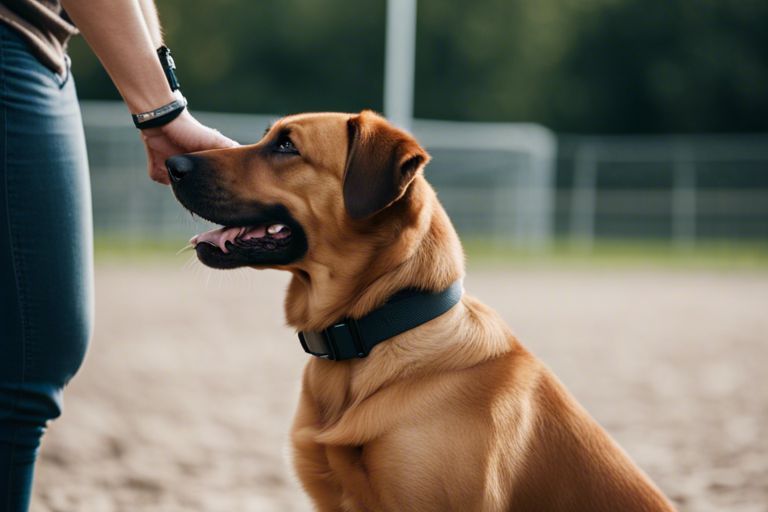Dogs display a range of behaviors that may puzzle or frustrate their owners. In this informative blog post, we will explore common behavior problems in dogs and provide effective training solutions to address them. Drawing from expert insights and practical strategies, this guide aims to help dog owners understand and tackle issues like barking, chewing, aggression, and more. By following these training solutions, you can build a stronger bond with your canine companion and create a harmonious home environment.
Key Takeaways:
- Consistent Training: Consistency is key when addressing common behavior problems in dogs. Setting clear boundaries and expectations helps dogs understand what is acceptable behavior.
- Positive Reinforcement: Using positive reinforcement techniques, such as treats or praise, can help encourage good behavior in dogs. This approach focuses on rewarding desired behaviors rather than punishing unwanted ones.
- Professional Help: In cases where behavior problems persist despite training efforts, seeking the help of a professional trainer or animal behaviorist can provide tailored solutions to address specific issues in your dog’s behavior.
Identifying the Problem
Recognizing Behavioral Changes
Changes in your dog’s behavior can signal an underlying issue that needs to be addressed. Pay attention to alterations in eating habits, energy levels, social interactions, and overall demeanor. Dogs, like humans, can display changes in behavior due to various reasons such as stress, health issues, or environmental factors. By recognizing these changes early on, you can intervene and prevent the development of serious behavior problems.
Common Behavioral Issues in Dogs
Identifying common behavioral issues in dogs is crucial for implementing effective training solutions. Some prevalent problems include aggression, separation anxiety, excessive barking, destructive chewing, and house soiling. These behaviors can stem from lack of socialization, fear, boredom, or a lack of mental stimulation. Understanding the root cause of these issues is key to addressing them appropriately and helping your dog become a well-adjusted companion.
Recognizing the signs of common behavior problems in dogs is the first step towards finding solutions that work. Each behavior concern may require a tailored approach to training and consistent reinforcement of desired behaviors. By identifying the problem early on and seeking guidance from a professional trainer or behaviorist, you can help your dog overcome behavioral issues and strengthen your bond.
Environmental Factors
Any behavior problems in dogs can often be linked to environmental factors that may be causing stress or confusion for the pet. Understanding how changes in their environment can impact their behavior is key to addressing and correcting these issues.
The Impact of Changes in Environment
One common factor that can lead to behavior problems in dogs is changes in their environment. Dogs are creatures of habit, and sudden changes such as moving to a new home, rearranging furniture, or introducing new pets can trigger anxiety and stress in them. This can manifest in various problem behaviors such as excessive barking, aggression, or house soiling.
Knowing how to identify these environmental triggers and address them with appropriate training solutions is important in helping your dog adapt and thrive in their surroundings.
How to Minimize Environmental Stressors
Environmental stressors can be minimized by creating a stable and consistent environment for your dog. This includes establishing a routine for feeding, exercise, and playtime, as well as providing a comfortable and safe space for them to retreat to when they need a break.
- Ensure that your dog has access to fresh water and a quiet place to rest.
- Consider using pheromone diffusers or calming supplements to help alleviate stress.
- Provide mental stimulation through interactive toys and training exercises to keep your dog engaged and prevent boredom.
With a structured and supportive environment, you can help your dog feel secure and reduce the likelihood of behavior problems arising due to environmental stressors.
Training Solutions
Many behavior problems in dogs can be effectively addressed through training solutions. By using positive reinforcement techniques and redirecting unwanted behaviors, pet owners can help their dogs learn appropriate behaviors and improve their overall well-being.
Positive Reinforcement Techniques
Solutions involving positive reinforcement are highly effective in training dogs. By rewarding good behavior with treats, praise, or play, dogs learn to associate positive outcomes with their actions. This encourages them to repeat the desired behavior, leading to long-lasting results.
Redirecting Unwanted Behaviors
For behavior problems like excessive barking or jumping, redirecting unwanted behaviors can be key. Instead of punishing the dog for the unwanted behavior, redirect their focus towards a more appropriate behavior. For example, if a dog jumps on guests, teach them to sit instead and reward them for sitting calmly.
Training techniques that focus on redirecting unwanted behaviors are based on the principle of replacing a negative behavior with a positive one. This not only helps to address the immediate issue but also teaches the dog what is expected of them in various situations.
Addressing Fear and Anxiety
Despite the loving and sociable nature of dogs, fear and anxiety can still be common behavior problems that owners may have to address. These emotions can manifest in various ways, such as trembling, cowering, excessive barking, or destructive behavior.
Identifying Fear Triggers
One of the first steps in addressing fear and anxiety in dogs is to identify the triggers that are causing these emotions. Dogs can be fearful of loud noises, unfamiliar people or animals, certain objects, or specific situations. By understanding what is causing the fear response, you can better tailor your training approach to help your dog overcome these issues.
Desensitization and Counterconditioning Techniques
Fear and anxiety in dogs can be effectively managed through desensitization and counterconditioning techniques. Desensitization involves gradually exposing the dog to the fear trigger in a controlled and gradual manner, helping them to become more comfortable and less reactive over time. Counterconditioning works by changing the dog’s emotional response to the fear trigger through positive associations, such as pairing the trigger with rewards or treats.
Understanding these techniques and applying them consistently can help your dog build confidence and overcome their fears, leading to a happier and more well-adjusted pet.

Managing Aggression
Recognizing Aggressive Behavior
Keep a close eye on your dog’s body language and vocalizations to recognize signs of aggression. Raised hackles, growling, baring teeth, and direct eye contact are all common indicators of aggression in dogs. It is crucial to intervene early to prevent aggressive behavior from escalating.
Strategies for Reducing Aggression
For effective aggression management, start by identifying the triggers that set off your dog’s aggressive behavior. It could be fear, territoriality, or resource guarding. Once you understand the root cause, work on desensitizing your dog to those triggers through behavior modification training. Positive reinforcement techniques can be highly effective in redirecting your dog’s behavior and rewarding calm, non-aggressive responses.
Aggression in dogs can be complex and challenging to address. Seeking the assistance of a professional dog trainer or behaviorist may be necessary to develop a tailored behavior modification plan for your dog. They can provide guidance on how to safely manage and modify your dog’s aggressive tendencies, ensuring a harmonious relationship between you and your furry companion.
Dealing with Destructive Behavior
Causes of Destructive Behavior
All too often, destructive behavior in dogs can stem from a variety of underlying causes. One common reason for destructive behavior is boredom and lack of mental stimulation. Dogs, especially active breeds, need both physical and mental exercise to stay happy and healthy. Another possible cause is separation anxiety, where dogs may become destructive when left alone due to stress and fear.
Redirecting Energy and Providing Appropriate Outlets
An effective way to address destructive behavior in dogs is to redirect their energy towards more appropriate outlets. Providing plenty of interactive toys, puzzle feeders, and regular exercise can help keep your dog mentally and physically engaged. Additionally, training your dog in obedience and teaching them commands like “leave it” can help redirect their focus away from destructive behaviors.
For instance, if your dog enjoys chewing, provide them with sturdy chew toys to redirect their natural chewing instincts. Keeping your dog engaged and mentally stimulated can help prevent destructive behaviors and strengthen the bond between you and your furry companion.
Summing up
Ultimately, troubleshooting common behavior problems in dogs requires a combination of patience, consistency, and positive reinforcement. By understanding the root cause of the behavior issue and implementing practical training solutions, dog owners can effectively address and modify their pet’s behavior. Bear in mind, each dog is unique, and it may take time to see progress, but with dedication and the right approach, it is possible to overcome common behavior problems in our furry companions.
FAQ
Q: What are some common behavior problems in dogs?
A: Common behavior problems in dogs include excessive barking, destructive chewing, digging, jumping on people, aggression, and separation anxiety.
Q: How can I address excessive barking in my dog?
A: To address excessive barking in your dog, you can try identifying the trigger, providing regular exercise, training with positive reinforcement, and seeking professional help if needed.
Q: What are some training solutions for aggression in dogs?
A: Training solutions for aggression in dogs include identifying the root cause, implementing behavior modification techniques, desensitization and counterconditioning, and consulting with a certified dog trainer or behaviorist.

